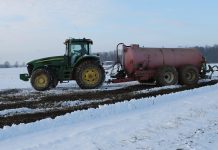By Chris Zoller and Eric Richer
You likely completed a balance sheet at the end of 2022 or the beginning of this year. Now may be a good time to use figures on the balance sheet to determine the financial health of your farm business. For more information, see this OSU Extension fact sheet: https://ohioline.osu.edu/factsheet/anr-0135.
Introduction
The balance sheet is one of four financial statements critical to the management and operation of a farm business. The other three are the income statement, cash flow statement, and statement of changes in owner’s equity. The balance sheet is arguably the simplest of the four but can provide a tremendous amount of information about the financial health of your farm, including the ability to measure the liquidity and solvency of your business.
A balance sheet includes two columns. The left column lists the assets of the business. The right column lists the liabilities incurred by the business. Subtracting liabilities from assets provides the calculated net worth, or equity, of the business. The balance sheet represents a financial snapshot in time of the business. If you have questions about developing a balance sheet, speak with your lender or review the Ohio State University Extension fact sheet, The Basics of a Farm Balance Sheet, at ohioline.osu.edu/factsheet/anr-64.
Using your balance sheet. If you are completing a balance sheet each year only to check a box that satisfies your lender, you are missing out on a number of useful learning opportunities, including:
• determining farm business valuation
• having a financial document that multiple generations can use to discuss a farm from a business perspective
• reviewing farm assets and how they are financed (debt vs. equity)
• understanding how much financial risk a farm can bear measuring farm financial health (growth, liquidity, solvency, and ratios)
• gauging farm financial performance by calculating ratios and comparing performance to industry standards
Calculations
Let’s review the calculations used to measure a farm’s health, what they mean, how they are calculated and what you can learn from them.
Liquidity measures the ability of a farm business to pay short-term (less than one–year) debts. Two ratios can be calculated to assess the liquidity of your business:
1. current ratio — considered strong if it is greater than 1.5. The formula for determining the current ratio is: current farm assets/current farm liabilities
2. working capital — varies by business size but should be positive. The formula for determining working capital is: total current farm assets – total current farm liabilities
Solvency is the ability of a farm to meet its long-term debt obligations. Three ratios can be calculated to measure the solvency of a farm:
1. Debt to asset ratio** — calculated using this formula: total farm liabilities/total farm assets
2. Equity to asset ratio** — calculated using this formula: total farm equity/total farm assets
**When added together, these two ratios should equal a value of 1.0.
3. Debt to equity ratio — calculated using this formula: total farm liabilities/total farm equity
Summary
Monitoring financial performance and measuring it against established standards are critical. These measures should be calculated annually, at a minimum, and then be used to make farm business decisions. Make time to review your balance sheet, complete the calculations described in this fact sheet and compare your calculations to industry standards. Consult your lender or Extension professional for more information.
(Chris Zoller is an Ohio State University Extension educator in Tuscarawas County. Eric Richer is the OSU Extension Field Specialist in Farm Management.)













